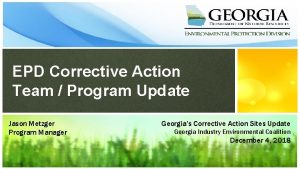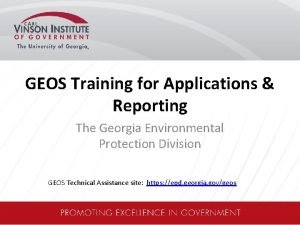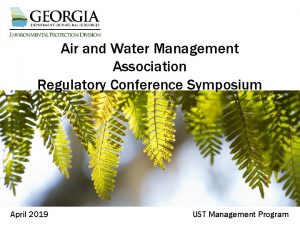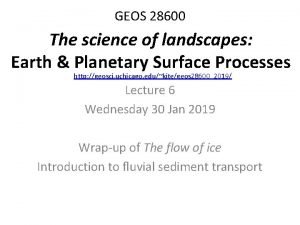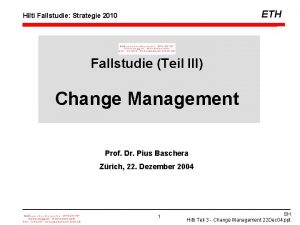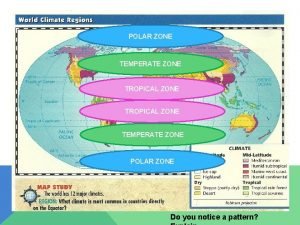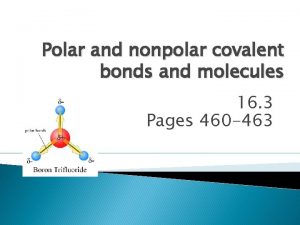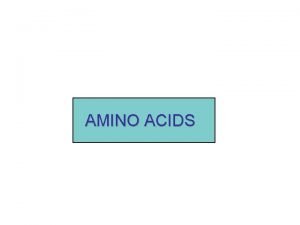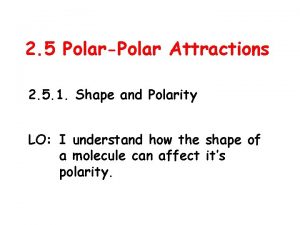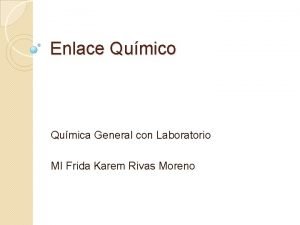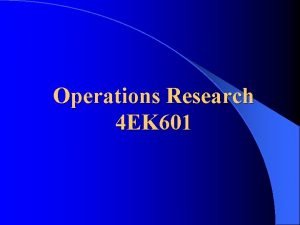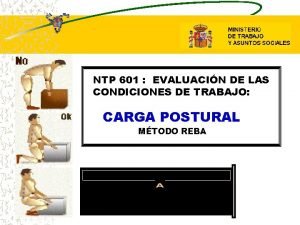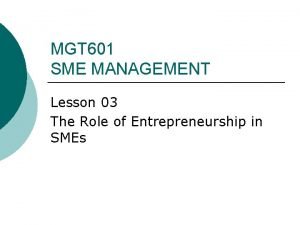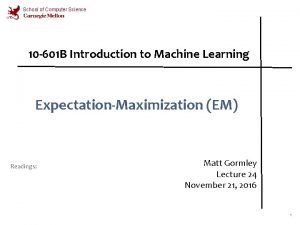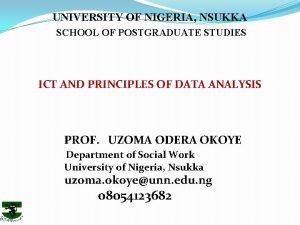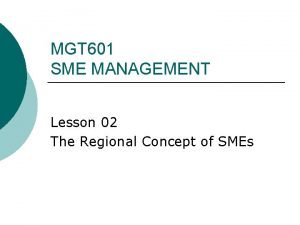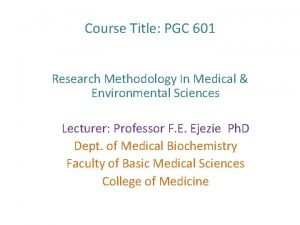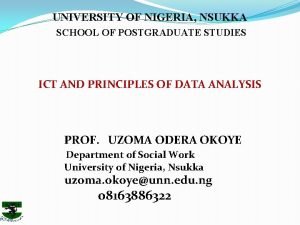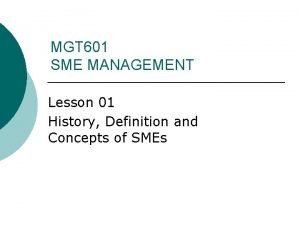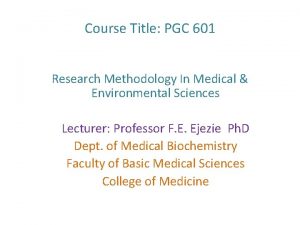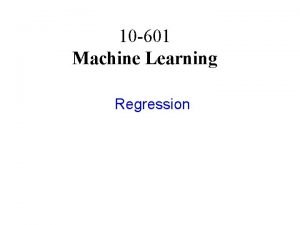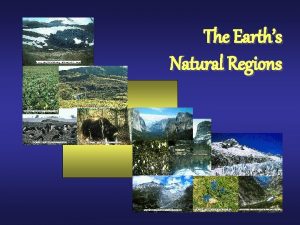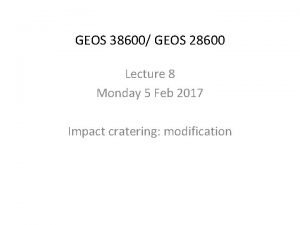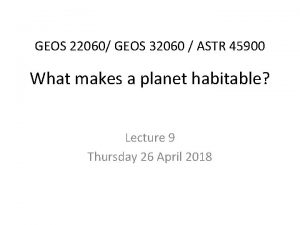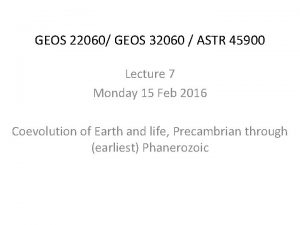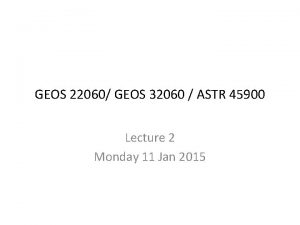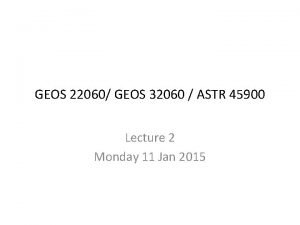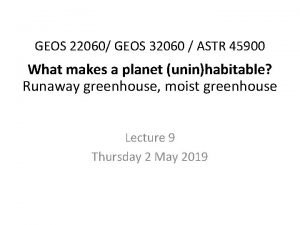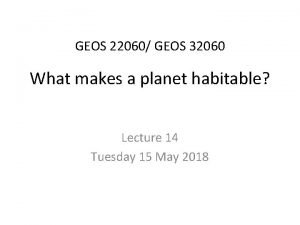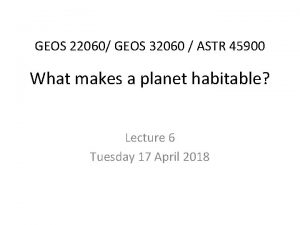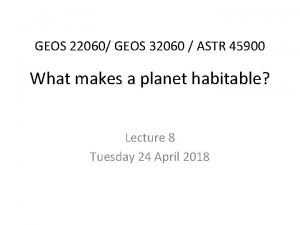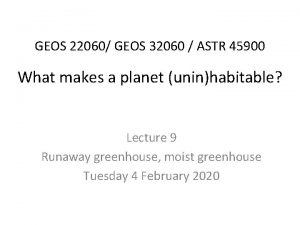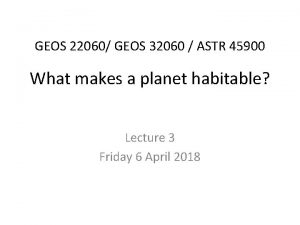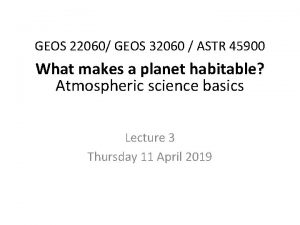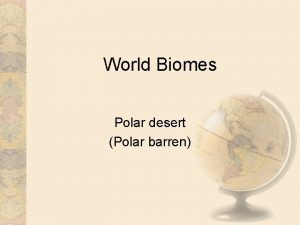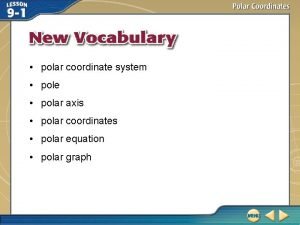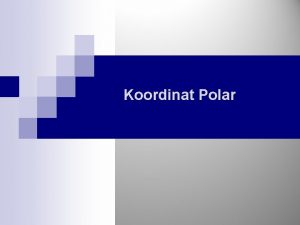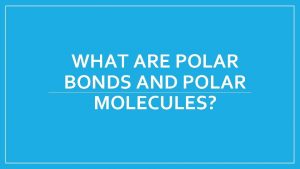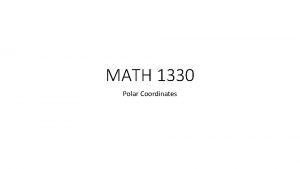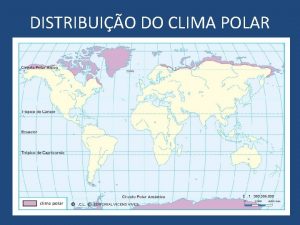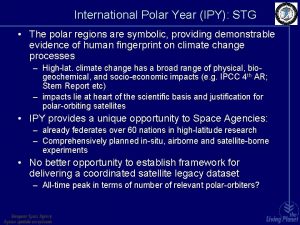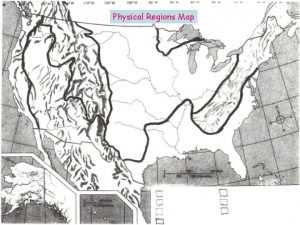GEOS 401 601 Earths Polar Regions Science Society















































- Slides: 47

GEOS 401 -601 Earth’s Polar Regions: Science, Society, and Discovery Polar Climate and Change Spring 2014 Instructors: Alejandro Orsi and Christina Wiederwohl

Physical Interactions at Polar Regions Temperature and moisture: major physical drivers of all natural ecosystems Climate Change 2013 Working Group I: The Physical Science Basis IPCC Report 2

• 2010 - 2012

2011 AR 5 2014

Climate Change https: //www. ipcc. ch/report/ar 5/wg 1/ Working Group I contribution to the IPCC Fifth Assessment Report (WGI AR 5)

Executive Summary • Human Activities Continue to Affect Earth’s Energy Budget 6 AR 5 2014

Key Concepts in Climate Science Climate is usually defined as the statistical description of relevant quantities based on their mean and variability over a period of time ranging from months to thousands or millions of years… in other words, the average weather Climate Change is usually is also statistically defined, so that it must persists for an extended period, typically decades or longer. AR 5 2014

Executive Summary • Human Activities Continue to Affect Earth’s Energy Budget 1) by changing the emissions of gases and aerosols into the atmosphere, thus their concentrations, that are important to (Solar and Earth) radiation 2) changing land ocean surface properties, e. g. its temperature Unequivocal evidence from in situ observations and ice core records shows that the atmospheric concentrations of important greenhouse gases such as carbon dioxide (CO 2), methane (CH 4), and nitrous oxide (N 2 O) have increased over the last few centuries. The most compelling evidence of climate change derives from observations of the atmosphere, land, oceans and cryosphere. AR 5 2014

Key Concepts in Climate Science There are many indicators of climate change, e. g. physical responses such as changes in surface temperature, atmospheric water vapour, precipitation, severe events, glaciers, ocean and land ice, and sea level. Global mean surface air temperatures over land oceans have increased over the last 100 years. AR 5 2014

Sea Ice Climatic Changes Rapid sea ice loss is one of the most prominent indicators of Arctic climate change. There has been a trend of decreasing Northern Hemisphere sea ice extent since 1978, with the summer of 2012 being the lowest in recorded history. The amount of multi-year sea ice has been reduced, i. e. , the sea ice has been thinning and thus the ice volume is reduced (Haas et al. , 2008; Kwok et al. , 2009). While AR 4 found no consistent trends in Antarctica sea ice, more recent studies indicate a small increase. A deepening of the low-pressure systems in West Antarctica caused stronger winds and enhanced ice production in the Ross Sea (Goosse et al. , 2009; Turner and Overland, 2009). AR 5 2014

Land Ice Climatic Changes The Greenland Ice Sheet has lost mass since the early 1990 s and the rate of loss has increased. Since 1979, the area experiencing surface melting has increased significantly (Tedesco, 2007; Mernild et al. , 2009), with 2010 breaking the record for surface melt area, runoff, and mass loss, and the unprecedented areal extent of surface melt of the Greenland Ice Sheet in 2012 (Nghiem et al. , 2012). The Antarctic continent now experiences a significant net loss of ice mass, occurring in the Amundsen Sea sector of West Antarctica and the northern Antarctic Peninsula. The ice sheet on the rest of the continent is relatively stable or thickening slightly (Lemke et al. , 2007; Scott et al. , 2009; Turner et al. , 2009). AR 5 2014

Multiple Lines of Evidence for Climate Change AR 5 2014 continuing increase in the heat content of the oceans trend of significant reductions in the mass balance of most land ice masses and in Arctic sea ice.

Executive Summary • Human Activities Continue to Affect Earth’s Energy Budget • Processes affecting climate exhibit considerable natural variability 1) they exist even in the absence of external forcing (e. g. anthropogenic) Many components of the climate system also exhibit multiple states that can switch in response to natural variability, or to external forcing 2) there are periodic and chaotic variations on a vast range of spatial and temporal scales The relationship between forcing and response seems reasonably linear for some components but also much more complex for others. There are many feedback mechanisms that can either amplify (‘positive feedback’) or diminish (‘negative feedback’) the effects of a change in climate forcing (Le Treut et al. , 2007) AR 5 2014

The Goals of the ACCE Initiative • To determine how the climate of the Antarctic has changed from deep time to the present • To estimate how these changes had affected the biota • To determine how the climate of the Antarctic and Southern Ocean will change over the next century under a range of greenhouse gas emission scenarios

Some Key Issues • The variability of the Antarctic climate system • The major impact of the ozone hole • The impact of climate change on marine and terrestrial ecosystems • Mass balance and the glaciological changes in West Antarctica • How the physical and biological environment will evolve over the next century and how we can produce improved predictions.

And … • The variability of Antarctic sea-ice-atmosphere interactions, and their impact on the global meridional overturning circulation and water masses stratification … thus TAMU’s active role with international WOCE and CLIVAR programs

The Polar Climates are More Variable Than Those of Lower Latitudes Turner, 2011

The Annual Cycle of Sea Ice Extent Sept Mar May Turner, 2011

Ice Variability and Temperature July 1987 July 1997 Faraday T -19. 9 Faraday T -8. 5 Turner, 2011

Tropical Influences Such as El Nino can Affect the Antarctic Wave trains of atmospheric anomalies propagate out into both hemispheres from the areas of tropical convection. Turner, 2011

The Dome C Oxygen Isotope Record Glaciation/deglaciation = extinction followed by re-colonisation of biological communities Turner, 2011

The Sea Ice Record • The satellite record starts in 1979 Turner, 2011

The Ozone Hole • Developed in the early 1980 s • Linked to the emission of CFC • Most pronounced in the spring when there is greater UV at the surface Turner, 2011

Stratospheric Temperatures at Halley Turner, 2011

The Ozone Hole Has Changed the Atmospheric Circulation Around Antarctica H L H Turner, 2011 H • We have strong winds over the Southern Ocean because of the pressure difference between the Antarctic and mid-latitudes

The Winds Over the Southern Ocean Have Increased Southward shift of the ACC The Southern Ocean storm track Zone of stronger winds Turner, 2011

The Southern Ocean is no Longer as Effective as a CO 2 Sink • From Le Querre et al. , 2007 • Sea-air CO 2 fluxes integrated over 45 – 90 S • The Southern Ocean sink of CO 2 has weakened by 0. 08 petagrams of carbon per year per decade over 1981 – 2004 relative to the trend expected from the increase in atmospheric CO 2 Turner, 2011

Most of the Antarctic Has Become More Isolated and Cooled Slightly Over the Last 30 Years • Whereas the winds around the Antarctic have increased, • the poleward heat flux has decreased, • giving a small cooling since about 1980 • • From Thomson and Solomon, 2002 Contribution of the ozone loss to Dec – May temperature and wind trends Turner, 2011

A Long-term Pattern of Antarctic Peninsula – East Antarctica Temperature Change • The correlation of stacked ice core isotopic records with model 2 m air temperature • The ice core data suggest the continent has warmed by 0. 2 C since the late 19 th century • From Schneider et al. , 2006 Turner, 2011

Why is the Antarctic Peninsula Warming? L The Amundsen Sea Low The Southern Ocean storm track L L Zone of stronger winds • The mean sea level pressure across the Southern Hemisphere Turner, 2011

The Deepening of the Amundsen Sea Low Break up of ice shelves on the eastern side of the peninsula Stronger northerlies Loss of sea ice in the Bellingshausen Sea • Sea level pressure changes as a result of the ozone hole Turner, 2011

Changes in the Terrestrial Ecology • Terrestrial organisms on the Antarctic Peninsula are responding to climate change, e. g. the flowering plants Deschampsia Antarctica and Colobanthus Quitensis are increasing at some sites Turner, 2011

Changes in the Terrestrial Ecology • Linked to decreases in Adelie penguin numbers, since they prefer snowfree habitats • Increasing Antarctic Peninsula precipitation/accumulation. • From Thomas et al. 2008 Turner, 2011

Marine Ecosystem Changes to the West of the Antarctic Peninsula • Changes in phytoplankton Stronger northerlies • Decline in krill stocks • Southward shift in population of gelatinous salps • Decrease in sea ice concentration Turner, 2011

Retreat of Glaciers SRESA 1 B • Cook et al. , 2005 • 87% of marine glaciers across the Antarctic Peninsula have retreated since 1953. Turner, 2011

The Amundsen Sea Embayment • • The result of changing water masses under the ice shelves rather than higher air temperatures Linked to changing winds off the coast • The most rapidly changing region of the ice sheet • Pine Island Glacier is moving at speeds 60% faster than during the 1970 s • Accelerated thinning of 5 glaciers • Mass loss of 50 – 137 Gt per year, equivalent to the total loss from the entire Greenland Ice sheet Responsible for 10% of global sea level rise Turner, 2011

Antarctic Mass Balance • Wingham et al. , 2006 • West Antarctica is certainly losing mass, mainly from the Amundsen Sea Embayment • There is an active debate over whether East Antarctica is essentially in balance or gaining mass slightly from greater snow accumulation Turner, 2011

Future Climate Change • IPCC CO 2 emission scenarios Turner, 2011

Atmospheric Circulation Recovery of stratospheric ozone + Increasing greenhouse gas concentrations Turner, 2011

Surface Temperature Trends 2000 -2100 Summer Winter • Mean of 0. 34 deg / decade over the continent • Largest warming over the high plateau of East Antarctica (3 deg) and the sea ice zone in winter (5 deg). • In 2100 temperatures across most of the continent will still be below freezing, limiting surface melt. • Regional detail is still difficult to predict Turner, 2011

Other Predicted Trends 2000 -2100 Winter sea ice concentration Accumulation (percent) • A one third reduction in annual mean sea ice extent • This could have major implications for Antarctic Bottom Water production, which would have implications for the global ocean circulation. • The higher air temperatures will promote greater precipitation at high latitudes Turner, 2011

Terrestrial Ice over the Next Century • Ice sheet models do not correctly simulate past changes at the moment. • Current areas of change are most likely to change over the next century, e. g. the Amundsen Sea Embayment. • There is a 30% chance that the WAIS could cause sea level rise of 2 mm per year, and a 5% change of a contribution of 1 cm/year. • THE POSSIBILITY THAT THE WAIS WILL CONTRIBUTE TENS OF CM BY 2100 CANNOT BE DISCOUNTED. Turner, 2011

Terrestrial Biology over the Next Century • Higher temperatures may promote growth and reproduction, but could cause drought. • Changes to water availability expected to have a greater impact than temperature increases. • Many species could exhibit faster metabolic rates, shorter life cycles and local expansions of population. • Lake ecosystems could change as a result of changes in precipitation and temperature. Turner, 2011

Marine Biology over the Next Century • Bottom water temperatures may rise by 0. 5 – 0. 75 C, with increases of greater than 1. 5 C limited to surface waters. • Most organisms live within a limited range of temperatures and may be sensitive to higher ocean temperatures. • As sea ice decreases marine algae will begin to disappear, with an impact on higher trophic levels in the food web. • The population of sea ice dependent species, such as emperor penguins, may be affected as ice retreats. Turner, 2011

Summary • The physical and biological systems of the Antarctic are complex and highly variable • Over the last 30 years the ozone hole has had a profound effect and shielded the Antarctic from much of the impact of ‘global warming’. • The ozone hole should recover by 2060 -70, but if greenhouse gas concentrations double temperatures could rise across the continent by ~3 °C and a third of sea ice lost. • There will be consequent effects on the terrestrial and marine ecosystems, with the possibility of some species becoming extinct. Turner, 2011

The Future of ACCE • We now have an Expert Group within SCAR to advise on climate-related matters and the potential impact on the biota. • This brings together scientists involved with the biological and physical sciences • We prepare an annual summary on recent advances in Antarctic science for the annual Antarctic Treaty meeting Turner, 2011

 Corrective action team
Corrective action team Georgia epd geos
Georgia epd geos Pro forma income statement example
Pro forma income statement example Geos epd
Geos epd Geos plumbing services
Geos plumbing services Geos hilti
Geos hilti Tropical temperate polar
Tropical temperate polar Polar and nonpolar
Polar and nonpolar Molecula polar y apolar
Molecula polar y apolar Polar and non-polar amino acids
Polar and non-polar amino acids Polar attractions are ...
Polar attractions are ... Polar and non polar dielectrics
Polar and non polar dielectrics Fqcolindres 2 eso
Fqcolindres 2 eso My favorite school subject
My favorite school subject Jaynell pittman
Jaynell pittman Ek 601
Ek 601 Ntp 601
Ntp 601 Mgt 601
Mgt 601 Http 601
Http 601 Primary care medicine goroll test bank
Primary care medicine goroll test bank Backpropagation logistic regression
Backpropagation logistic regression 601(b)(10)
601(b)(10) Pgc 601
Pgc 601 Mgt 601
Mgt 601 Pgc 601
Pgc 601 Deffibrilator
Deffibrilator Pgc 601
Pgc 601 Usine peugeot
Usine peugeot Itcp in mobile computing
Itcp in mobile computing Hino 601
Hino 601 601(b)(10)
601(b)(10) Werribee italian social club
Werribee italian social club Mgt 601
Mgt 601 Pgc world
Pgc world Regression
Regression Earths layer foldable
Earths layer foldable Earths roation
Earths roation Whats earths moon called
Whats earths moon called What makes one biome different from another?
What makes one biome different from another? What is the most abundant element on earth
What is the most abundant element on earth Plasticity in earth's layers
Plasticity in earth's layers Whats earths moon called
Whats earths moon called What is earths thickest layer
What is earths thickest layer Earths early atmosphere contained
Earths early atmosphere contained Earth's layer foldable
Earth's layer foldable Earths major crustal plates
Earths major crustal plates Earths orbit seasons
Earths orbit seasons Brown earth soil ireland
Brown earth soil ireland
